
 Christian Hazel
Brand Manager, Four Wheeler
Christian Hazel
Brand Manager, Four Wheeler
I'm an engine junkie. I pore over dyno tests, study cylinder head flow numbers, and speculate on camshaft selections. Yeah, geek. But, in all that research it occurred to me that I could take the GM Performance Parts 350/290hp crate engine from my '68 M-715 and upgrade it with a few select components to shoot for a 400hp/400lb-ft recipe that anybody could duplicate with no machine shop and only basic mechanical skills. Why so focused on the ubiquitous small-block Chevy in a Jeep magazine? Well, it's still the engine most commonly swapped into Jeeps both old and new and there are literally thousands of Jeeps running around already sporting small-block Chevy power.
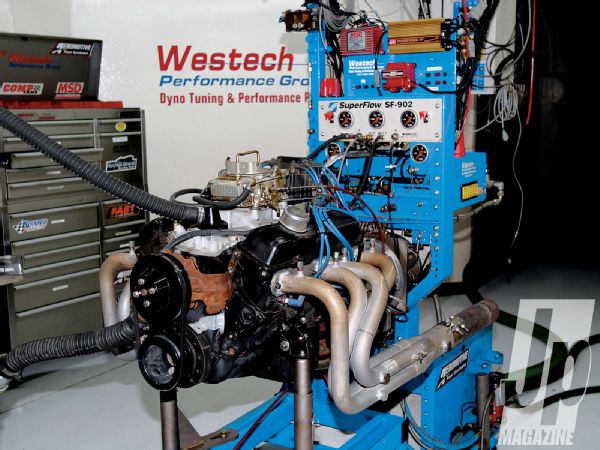
The Test Engine
The GM Performance Parts PN 12499529 350/290hp engine used in this test is based on a GM Goodwrench long-block with a sturdy 4-bolt main bottom end and production-spec cast aluminum dished pistons. It's indicative of any '70s-'80s GM V-8 small-block you may find at your local auto recycler's, although the GMPP 290hp does benefit from a better Nodular iron crankshaft and stronger powdered metal connecting rods. Despite its rated 8.5:1 compression ratio, in reality the production-spec 76cc open chamber cylinder heads and a piston that lives about 0.038-inch in the hole deliver 8.0:1-8.25:1. It's great for use with 87-octane fuel, but doesn't scream high-performance. Regardless, if you can't afford to duplicate our efforts using a factory-fresh GM Performance short block, you can substitute any decent $100 junkyard short block with the same results.
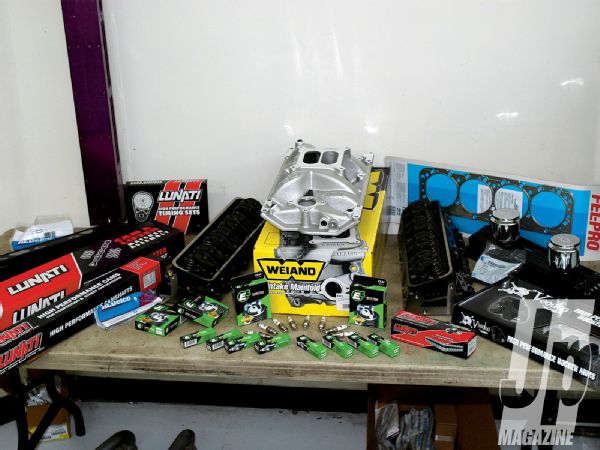 After baselining the engine as it ran in the truck, the crew at Westech Performance upgraded the GMPP 290hp engine with the parts you see here. Highlights include a Lunati Voodoo 268 camshaft setup, Lunati self-aligning Voodoo roller rockers, a Weiand Stealth Air Strike intake manifold, and bunch of stuff from GM Performance Parts including the assembled Vortec heads, heavy-duty pushrods, circle track valve covers, and other goodies you'll read about next month. Note the green packages in the foreground. We used E3 spark plugs for all of our dyno testing.
After baselining the engine as it ran in the truck, the crew at Westech Performance upgraded the GMPP 290hp engine with the parts you see here. Highlights include a Lunati Voodoo 268 camshaft setup, Lunati self-aligning Voodoo roller rockers, a Weiand Stealth Air Strike intake manifold, and bunch of stuff from GM Performance Parts including the assembled Vortec heads, heavy-duty pushrods, circle track valve covers, and other goodies you'll read about next month. Note the green packages in the foreground. We used E3 spark plugs for all of our dyno testing.
The Main Players
Check out the sidebar "Head Specs" for the full rundown, but in a nutshell, when GM took the LT1 cylinder head and tweaked it for use in its '96-'00 5.7L-equipped trucks and SUVs, it created one of the best off-the-shelf iron cylinder heads ever made for the small-block Chevy. The 906 and 062 Vortec heads (referred to by the last 3 digits of their casting numbers) feature raised intake ports, high-quench 64cc combustion chambers, and 1.94-inch intake and 1.50-inch exhaust valves. When compared with some aftermarket heads, the valve size and rated 170cc port volume may seem small, but when you look at the flow numbers, especially in the crucial mid-lift values of 0.300-0.400-inch lift, you realize how much velocity the port shape and size generate. This allows the Vortecs to deliver as much or more airflow as many expensive aftermarket heads at levels below 0.500-inch valve lift where all the greasy, gooey torque lives. The only bummers with the Vortecs are the factory springs are good to only 0.475-inch valve lift before coil bind and valve control with high-lift cams becomes an issue, and they require a Vortec-specific intake manifold. If you're lucky, you can find Vortec heads in the junkyard for about $150 or so if you scrounge. However, you can still buy brand new, fully-assembled Vortec heads through GM Performance Parts for less than $600/pair. That's a screamin' deal. GMPP also has all the necessary gaskets, fasteners, and other parts required for the Vortec conversion, but more on that next time.
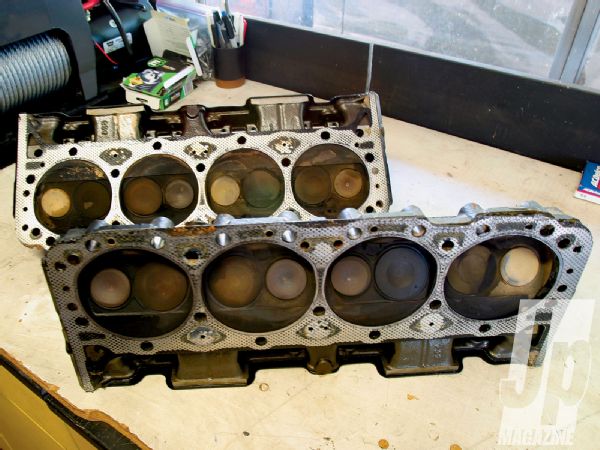 Note the deep, open chamber design of the factory 76cc cylinder heads. With lazy, low-velocity intake ports full of restrictions and a cavernous combustion chamber these heads only just get the job done. In the past, builders would spend hours hogging, milling, and porting just to make the same power you can get out of an uncut set of Vortec heads.
Note the deep, open chamber design of the factory 76cc cylinder heads. With lazy, low-velocity intake ports full of restrictions and a cavernous combustion chamber these heads only just get the job done. In the past, builders would spend hours hogging, milling, and porting just to make the same power you can get out of an uncut set of Vortec heads.
To complement the airflow characteristics of the Vortec heads, keeping in mind that the flow is pretty played out by 0.500-inch lift, a Lunati Voodoo camshaft with an advertised duration of 268 intake/ 276 exhaust got the nod. The duration runs 227/233 @ 0.050 and lift comes in at 0.489/0.0504 with 1.5:1 ratio rockers. While the Vortecs feature great intake ports, the exhaust ports flow only marginally better than the 76cc iron heads they're replacing, so the longer duration and higher lift of the exhaust lobe on the Voodoo camshaft will help expel the exhaust gasses. The Voodoo camshaft also features the most aggressive flat-tappet profiles on the market, keeping the lifter on the seat almost as long as a hydraulic roller before snapping the valve open. Furthermore, the Voodoo lobes are asymmetrical. Although they really open the valve with authority, the closing ramp is ground with a smoother profile to allow the valve to close more softly for prolonged valvetrain life.
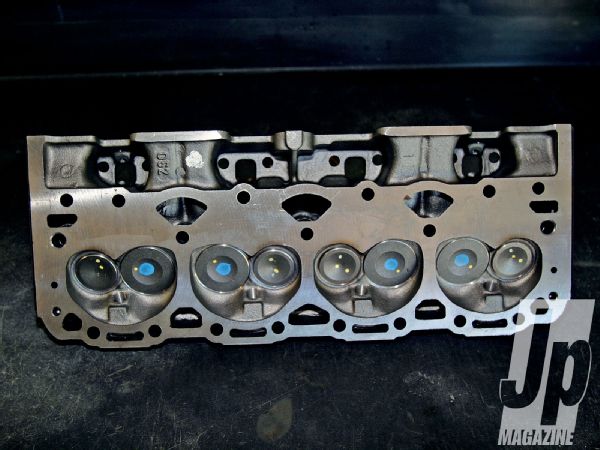 Here's the high-quench combustion chamber of the Vortec head. The chamber size and shape promotes flame propagation for a more complete burn, better resistance to detonation, and simply more power.
Here's the high-quench combustion chamber of the Vortec head. The chamber size and shape promotes flame propagation for a more complete burn, better resistance to detonation, and simply more power.
Since our Wieand Action Plus intake wouldn't work with the new heads and since we were upping the powerband and moving more air, we ordered a Weiand Stealth Air Strike high rise, dual plane intake with the Vortec pattern. The Air Strike features isolated runners that won't soak up engine heat and allow for a cooler, denser intake charge.
The Testing Troubles
With the heads, intake, and camshaft sorted, that only left the valvespring issue to deal with. And that's where I hit a wall. Standard high-performance valve springs require machining of the Vortec's valve pocket and valve guide. It's no secret that you can skip the machine shop by installing LS-style beehive valve springs over the uncut 0.900-inch spring seat of the Vortec heads. In an effort to avoid costly aftermarket springs, I first tried a set of factory LS6 springs. On paper they should have worked, but the LS6 springs went into coil bind at about 1.30-1.34-inch, which is earlier than spec'd, so that was out. Then, Lunati sent a set of its new 74881LUN springs and its 75787LUN retainers that delivered a seat pressure of 100lbs at an installed height of 1.750-inch. These springs worked great up until about 5,300rpm, at which point the aggressive Voodoo profile began manhandling them. Some Lunati 74818LUN springs should fix the instability issues, but we won't know until the engine takes another ride on the Westech Performance dyno. Tune in next time for the complete engine specs, part numbers, prices, and dyno results.
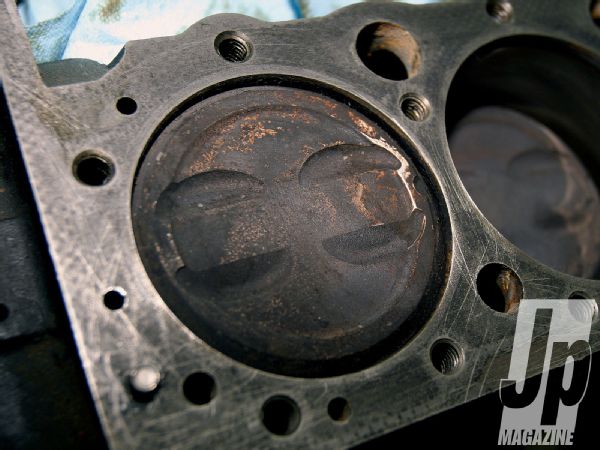 Like most production Chevy small-block engines of the '70s-'80s, the GMPP 290hp engine uses standard cast, dished pistons that only offer up 8.0:1-8.25:1 compression with the standard 76cc iron heads of the era. When used with Fel Pro PN 1094 steel shim head gaskets, the smaller 64cc combustion chambers of the Vortec heads up the compression to roughly 9.15:1.
PhotosView Slideshow
Like most production Chevy small-block engines of the '70s-'80s, the GMPP 290hp engine uses standard cast, dished pistons that only offer up 8.0:1-8.25:1 compression with the standard 76cc iron heads of the era. When used with Fel Pro PN 1094 steel shim head gaskets, the smaller 64cc combustion chambers of the Vortec heads up the compression to roughly 9.15:1.
PhotosView Slideshow


